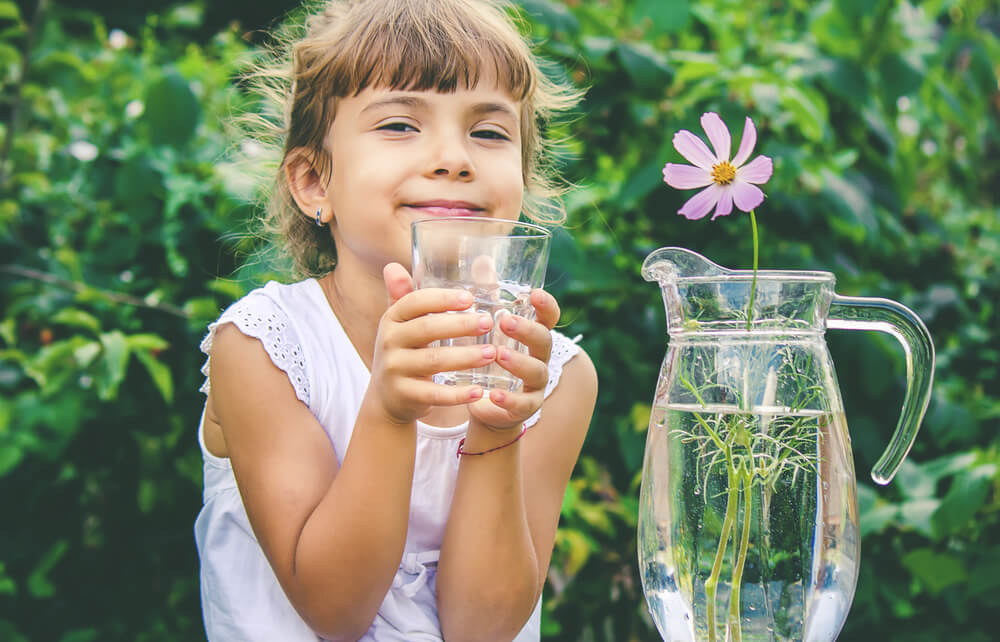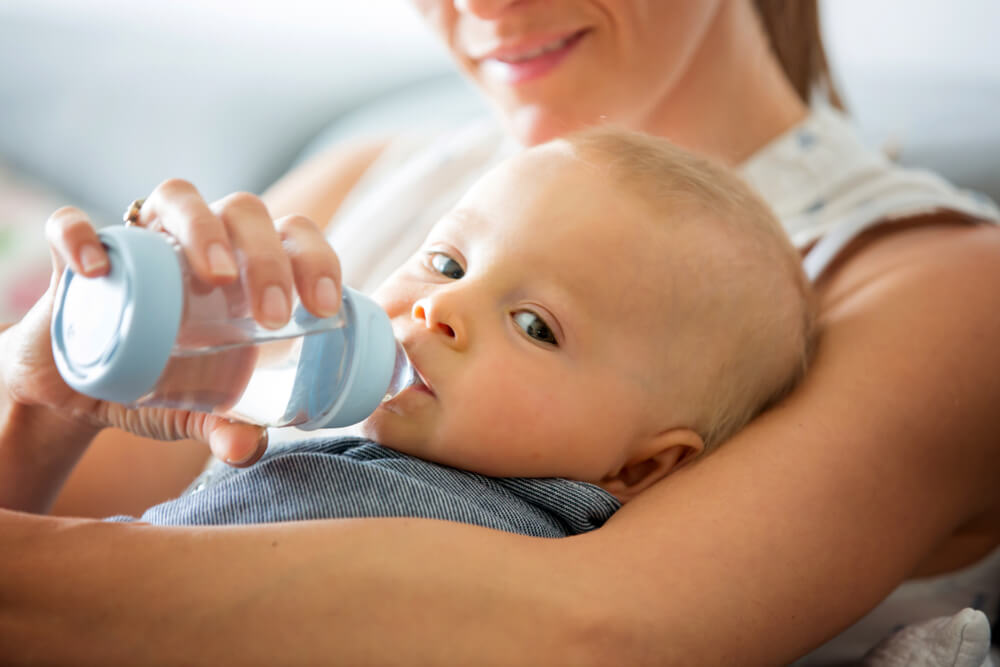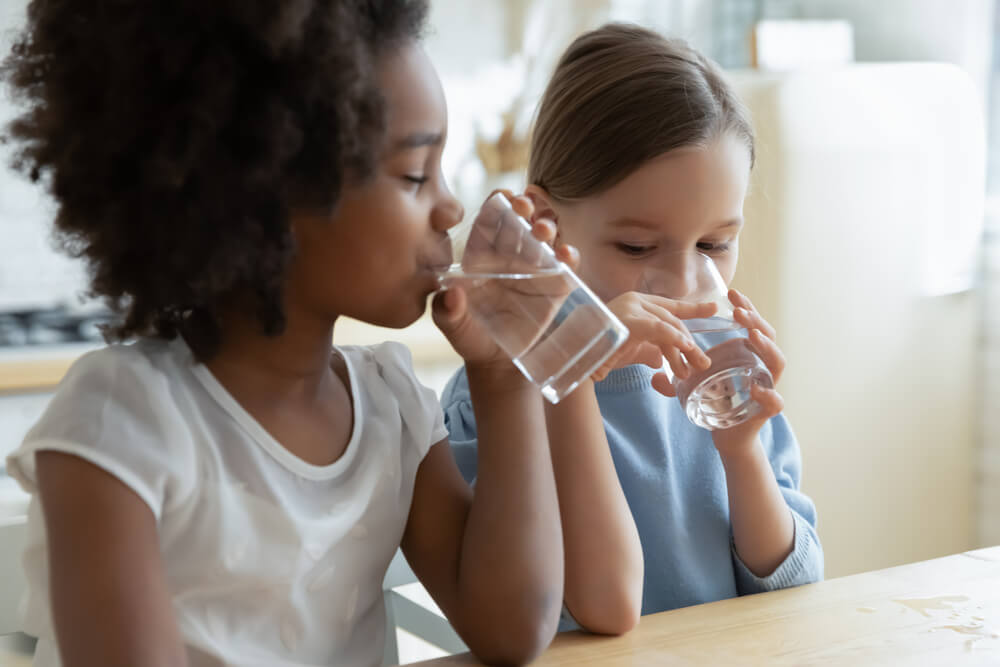Proper Hydration for Kids: How Much Water Do They Need?

We all know that drinking water is important for our health, but how much water should kids drink? As parents, it’s our responsibility to keep our children hydrated, especially during the hot and humid summer months.
Dehydration can cause a range of problems, from tiredness and headaches to more severe conditions like heatstroke. And while we can practically guarantee that keeping your kids healthy and feeling well is your top priority, the reality is that getting your kids to stay hydrated can often feel like an uphill battle.
In this blog, we’ll give you a guide on how much water your kids should consume—and some pain-free tips on how to encourage them to drink more.
Contents:
- Why Do Kids Need to Drink Water?
- How Much Water Do Children Need?
- When Can a Baby Drink Water?
- Signs of Dehydration
- How to Get Kids to Drink More Water
- How to Help Your Family Choose the Right Water
- Drinks to Limit
- FAQ
Why Do Kids Need to Drink Water?

Tatevosian Yana/Shutterstock.com
Water is essential for every cell in the human body to function correctly, but it’s especially crucial for kids who are still growing and developing. Their bodies can’t regulate their temperature as well as adults, so they’re more prone to heat stroke or exhaustion. Plus, kids sweat more than adults, which means that they need to replace the fluids they’re losing.
Dehydration occurs when your body loses more fluids than it takes in. If your kids don’t drink enough water to replenish what they’ve lost, it can lead to a variety of problems.
Some of the most common symptoms of dehydration in kids include fatigue, irritability, dry mouth, and dizziness. In severe cases, dehydration can cause heat exhaustion, which can lead to heatstroke. This serious condition can cause seizures, brain damage, or even death.
How Much Water Do Children Need?
So how much water do children need? And should the amount vary depending on their age?
Here’s an overview.
Babies and Toddlers (0-24 Months)
Infants under six months old get all the water they need from breast milk or formula. However, babies aged 6-12 months can get sips of water between feedings. Do not give water to a baby younger than six months unless directed by a doctor.
If your toddler is 1 to 2 years old, they should drink about two to four cups of water per day. You can start giving them water even if they continue to breastfeed or drink formula.
Preschoolers (2-5 Years)
For preschool-aged children, the recommended water intake is 36 to 48 ounces (1070 to 1420 ml) per day. This equals around five to six glasses of water daily. At this age group, it’s essential to teach children the importance of staying hydrated, especially during hot weather that can make them more prone to dehydration.
Elementary Children (6-12 Years)
For children aged 6-12 years old, the recommended daily water intake is eight to ten cups of water, roughly 56 to 71 ounces (1660 to 2100 ml) per day. Encourage your child to drink from a refillable water bottle, making sure they drink at least a couple of bottles a day.
Teenagers (13-18 Years)
As your child moves up to the teenage years, their water needs continue to grow. Teens should drink around eight to ten cups of water daily or to make it simple, try and shoot for around 64 to 72 ounces (1890 ml) a day. Encourage water intake and give them a refillable water bottle to bring with them when they go to school or out with friends.
When Can a Baby Drink Water?

Tomsickova Tatyana/Shutterstock.com
The general rule of thumb is that babies under 6 months old should not drink water. This is because their bodies are not yet equipped to process it properly, and too much water can actually be harmful. Babies under 6 months of age should get all their fluids from breast milk or formula.
Once babies hit the 6-month mark, they can start having sips of water in addition to breastmilk or formula. However, it’s important to note that water should not replace milk as their main source of hydration. The American Academy of Pediatrics suggests offering small amounts of water (no more than 2 ounces) in a sippy cup after meals.
As babies grow and reach their first birthday, they can start drinking more water. By this age, they should be drinking around 4 cups (32 ounces) of fluids per day, including breastmilk or formula. However, it’s still important to note that water should not replace milk as the main source of hydration until around 12 months.
Signs of Dehydration
Dehydration can be particularly tricky in kids because they may not be able to effectively communicate what they’re feeling. Luckily, there are signs and symptoms you can look out for to ensure your child is well-hydrated.
Dry Mouth and Tongue
It’s a classic symptom of dehydration, but it still bears mentioning. A dry mouth and tongue can indicate that your child is not getting enough fluids. If you notice that their lips are dry and cracked, it may be an even stronger indicator that they need more water.
Encourage them to drink fluids and avoid sugary drinks that can exacerbate dehydration. If your child is too young to drink water on their own, try using a spray bottle to mist their mouth with water instead.
Dark Urine
The color of your child’s urine can be a strong indicator of dehydration. If it’s darker than usual, you should be concerned. Dark yellow urine can also be a sign of infection, so if you notice it, you should check for other symptoms like pain or fever.
Sunken Eyes
If your child’s eyes look sunken or there are deep shadows under them, it may be a sign of dehydration. This can happen because the fluid in the body is being redirected to other vital organs, leaving the eyes looking tired and haggard.
Fatigue and Irritability
Dehydration can make your child feel tired, sluggish, and irritable. If your child doesn’t have the energy to play or seems cranky and anxious, it could mean they’re not getting enough fluids.
Headaches, Dizziness, or Fainting
In severe cases of dehydration, your child might become dizzy, have a headache, or even faint. If this happens, seek medical attention immediately. These symptoms can indicate a dangerous level of dehydration and will require medical intervention.
Take care of both your child’s health and safety. Especially if they attend daycare or have started school—meaning, they spend a lot of time away from you. To always know where your child is and whether everything is fine with them, install the Findmykids app right now!
How to Get Kids to Drink More Water

Odua Images/Shutterstock.com
We all know how important water is for our kids’ health and hydration—and yet, getting them to drink enough water can be quite a challenge. With so many sugary drinks and juices readily available, it’s easy for kids to overlook the importance of water.
But fear not, we’ve come up with some tips and tricks to help your little ones stay hydrated and healthy.
Make it Fun
Drinking water doesn’t have to be boring. You can make it more exciting by adding a slice of lemon, lime, or cucumber to their water. You can purchase adorable reusable water bottles with their favorite cartoon characters or superheroes. Adding a pop of color always helps to make things more appealing to kids.
Set a Good Example
Kids learn from what they see, so if you want to encourage them to drink more water, start by setting a good example. Make sure you’re also drinking enough water throughout the day. Refill your water bottle when they refill theirs and drink it together.
Another tip—you can create a friendly competition around drinking water. Set goals for the whole family, and whoever drinks the most water in a week wins a prize!
Limit Sugary Beverages
To get your kids to drink more water, you may need to limit their intake of sugary, non-hydrating drinks. Water should be their primary source of hydration.
Avoid offering soda, sports drinks, and other sugary beverages, which can lead to dehydration and tooth decay. If your kids are used to drinking these drinks, then it may take some time to switch them over to water, but don’t worry—they’ll get there!
Make it Easily Accessible
Make sure that water is easily accessible and available to your child throughout the day. Encourage your kids to always have a water bottle with them and refill it whenever they get a chance. You can even make it more accessible by setting up a water dispenser at home and placing it where they spend most of their time—the study or dining room, for example.
Get Creative
If your child still isn’t a fan of plain old water, then there are other options that you can try.
For example, infuse drinks with fruit, make them into popsicles or create ice cubes with juice. These options provide great alternatives to drinking plain water, while still keeping them hydrated.
How to Help Your Family Choose the Right Water

Lopolo/Shutterstock.com
Water is important. We get that! But how do you go about choosing the right water for your kids?
In most cases, plain tap water is fine. However, if you’re out and about and need to pick up some water quickly, you might be wondering what’s safe and what’s not. Let’s go over some of the best options.
Are Plastic Water Bottles Safe for Kids?
Plastic water bottles have become a common sight in our daily lives. While they are convenient, many parents wonder if they are safe for their kids.
The truth is that using plastic water bottles, especially those made with BPA (bisphenol A), can be harmful to both the environment and our health. BPA is a chemical that is used to make plastic and has been associated with numerous health problems.
As an alternative to plastic bottles, consider purchasing stainless steel bottles that are durable and reusable.
What is the Best Type of Water to Give a Child?
As mentioned earlier, tap water is a common source of drinking water for many families. While it is regulated by the government, it can still contain harmful toxins such as lead and chlorine. Speak with your local water supplier to find out the quality of your tap water and determine whether it is safe for your kids.
Also, investing in a water filtration system, such as a Brita filter, can help remove any impurities from your tap water. Keep in mind that a filtration system requires regular maintenance to ensure that it is working correctly, but nevertheless, this option can save you a fair bit of stress (and money).
Another option is bottled water. Not all bottled water is created equal, and some brands may contain harmful toxins (as mentioned earlier).
When selecting bottled water, look for brands that are sourced from natural springs or purified through reverse osmosis. These methods remove impurities and contaminants from the water, making it safer for your child to drink.
Be mindful of the type of plastic used in the bottles. Look for bottles that are made from PET (polyethylene terephthalate) or HDPE (high-density polyethylene) plastic, as they are safer for both the environment and our health.
Finally, filtered water is an excellent option for families who are concerned about the safety and quality of their drinking water. There are a few different types of water filters available, such as carbon filters and reverse osmosis filters.
Carbon filters are an affordable and effective way to remove impurities and improve the taste of your water. Reverse osmosis filters, on the other hand, are more expensive but can remove up to 99% of impurities in your water. Consider your family’s budget and water needs when selecting a water filter.
Drinks to Limit

Kmpzzz/Shutterstock.com
Now that we know how important it is to stay properly hydrated, you might be wondering whether other beverages might count toward your child’s drink quota. After all, getting in the recommended amount of water can be a challenge, especially if your child is used to sugary drinks and juice.
Soda
The number one beverage that should be limited for your child’s health is soda. Soda is high in sugar and empty calories, which can lead to weight gain, poor dental health, and an increased risk for type 2 diabetes.
Furthermore, the caffeine content can affect your child’s sleep pattern, something that’s crucial for their growth and development.
Instead of soda, opt for water, milk, or 100% fruit juices. If your child is craving a fizzy drink, try sparkling water with a splash of fruit juice.
Energy Drinks
Energy drinks are also a no-go for children. These beverages are loaded with caffeine, sugar, and other stimulants that can affect your child’s heart rate, blood pressure, and overall health.
In addition, the high sugar content (as is the case with soda) can lead to tooth decay and weight gain. Instead of energy drinks, encourage your child to get their energy from healthy foods and regular exercise.
Sweetened Beverages
Sweetened beverages include fruit drinks, sports drinks, and flavored milk. These beverages are high in sugar and calories and can lead to weight gain and tooth decay. While juice and sweetened milk might be okay in moderation, these should be limited as much as possible. There are a few reasons for this.
For one, fruit drinks often contain little to no real fruit juice, but instead are artificially flavored and colored. Sports drinks are marketed to replace fluids and electrolytes lost during exercise but are often high in sugar and calories.
And while plain milk is A-OK, flavored milk may contain added sugars and artificial flavors. Instead of sweetened beverages, opt for water, plain milk, or 100% fruit juice.
Coffee
As tempting as it may be to share a cup of coffee with your child in the morning (or even let your curious little one take a sip every now and then), it’s best to avoid it entirely or limit their intake.
Coffee contains caffeine, which can affect your child’s sleep pattern, mood, and growth.
Not only that but the added sugars and flavors in coffee can lead to weight gain and poor dental health. Instead of coffee, try a warm cup of cocoa or herbal tea.
The Takeaway

fizkes/Shutterstock.com
Water is essential for children’s health, and it’s our responsibility as parents to ensure they are consuming enough. By following these guidelines and encouraging them to drink more, we can help our kids stay hydrated and healthy. Remember—hydration is key to a happy and active childhood.
Now that’s something we can all drink to!
FAQ
How much water should a child drink a day in liters?
Water intake requirements depend on a child’s age, weight, gender, and activity level. As a general rule of thumb, children aged 1 to 3 years old should drink around 1 to 1.3 liters of water per day, while those aged 4 to 8 years old should drink 1.4 to 1.7 liters daily.
Can a 13-year-old drink 4 liters of water?
While staying hydrated is absolutely vital, consuming too much water can also be dangerous. Drinking 4 liters of water per day may cause water intoxication, in which excess water dilutes the body’s electrolytes, potentially leading to seizures, brain damage, and even death.
How much water should a 1-year-old drink?
For one-year-olds, the recommended daily water intake varies from 0.8 to 1.1 liters. However, keep in mind that milk and other liquids contribute to a child’s total water intake—ask your pediatric doctor for more recommendations on how many cups of water your child should be drinking at that age.
How much water should a 2-year-old drink in liters?
Two-year-olds require roughly the same amount of fluids as one-year-olds, approximately 0.8 to 1.1 liters. Make drinking water a part of your child’s daily routine, offer fluids frequently, and create fun ways to encourage drinking.
How many liters of water does a 7-year-old need?
Children aged 4 to 8 years old, which includes seven-year-olds, require 1.4 to 1.7 liters of water intake daily. This amount can increase when your kids are sweating a lot or engaging in intense physical activities.
Cover image: Tatevosian Yana/Shutterstock.com
Проверьте электронный ящик



















